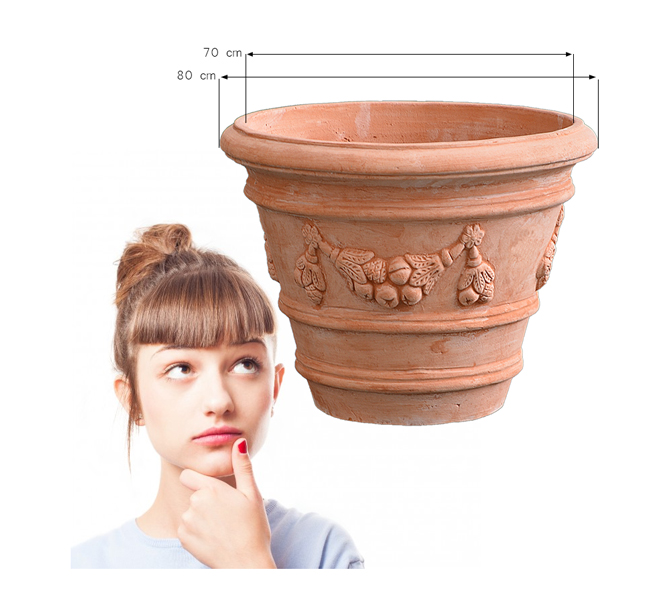
Today we want to talk about a seemingly trivial topic, but I assure you that it is often, even on the occasion of orders from customers with many years of experience,
a source of misunderstandings and confusion. I am talking about measuring the diameter of a round vase.
Our gardener or the architect who designed our garden, terrace or beautiful green space, tells us that we should put a pot, a planter or a tub of 100 centimeters.
Well, what's difficult about that? We open our Google and search for "100 centimeter vase". And here come the doubts. There are not many details in the product descriptions,
and it is not clear what the 100 centimeters refer to: the external or internal measurement? You see, there is a big difference, even in price. The external measurement
is the overall size of the vase. If you have a specific space to place the terracotta, you must be sure that the measurement you read on the product description is
the external one. However, the external 100 centimeters do not indicate the capacity of the vase. If your gardener or the seller of the plant you want to plant tells
you that you need a 100-centimeter vase, you must make sure that they do not mean that the plant needs a hole of 100 centimeters, which is precisely the measurement
from the inside of the vase.
The manufacturers certainly do not clarify within their product descriptions. Some indicate external or overall dimensions for certain types of pots, such as square or rectangular planters, jars, and amphorae, while for round pots they indicate internal dimensions. It is not uncommon for the famous lemon or double-border pot to be identified by its internal measurement, while other designs are expressed with the external measurement. In short, it can be quite confusing.The manufacturers certainly do not clarify within their product descriptions. Some indicate external or overall dimensions for certain types of pots, such as square or rectangular planters, jars, and amphorae, while for round pots they indicate internal dimensions. It is not uncommon for the famous lemon or double-border pot to be identified by its internal measurement, while other designs are expressed with the external measurement. In short, it can be quite confusing.
But why isn't there clarity? It's a good question that we don't know how to answer. It's probably errors that manufacturers have been carrying for a long time, when the market was mostly local, when customers year after year were always the same and knew the production even better than the producers. The point is that today there is still no uniformity in measurement and it's always good to specify what you are looking for, whether it's external or internal measurement.
How is a terracotta vase measured? It may seem like a simple question with an obvious answer, but in reality, it is not. If we don't seek clarity when buying or requesting a quote for our pot, we could make an incorrect assessment. In this article, we will explain the criteria used for this measurement, which we consider outdated and misleading, but are still adopted by some manufacturers and can cause confusion for those looking to choose their terracotta pot
It's believed that internal measurement was used to describe a container suitable for accommodating a plant whose root ball had a certain volume. Therefore, it was suitable for measuring a round pot, usually the classic lemon pot. It was realized that this type of measurement was not suitable for classifying pots of different shapes, such as squares and rectangles, which are often used to create dividing lines, and therefore to better understand, the measurement of overall size, usually length, should be used. A planter of 100 centimeters identifies an external rectangular pot that is 100 centimeters long. Often, to identify this container, the width and height are not even specified. For certain types of pots, such as tall squares or jars, the measurement that describes them is their height. A 100-centimeter pillar is undoubtedly a square pot that is one meter tall. Just as a 100-centimeter jar is a Tuscan jar that is 100 centimeters tall. In the Impruneta area, for example, rest assured that a pot that is 100 centimeters in size has an internal measurement of 100 centimeters at the upper rim.
Today, most manufacturers selling internationally use the principle of external measurement, and we are confident that soon measurement will no longer be a reason for doubt. Perhaps we notice that their code refers to internal notation because now the code is a consolidated data over the years, and to avoid confusion with old customers, the same code is reported. However, we wrote this article to warn that this type of misunderstanding can arise, especially when we think we have found a heavily discounted item without considering that it could actually be a smaller size. That being said, happy shopping to everyone.

